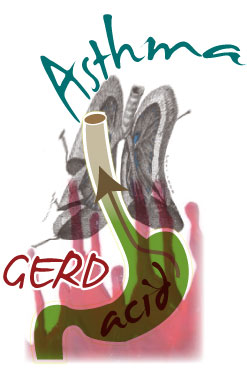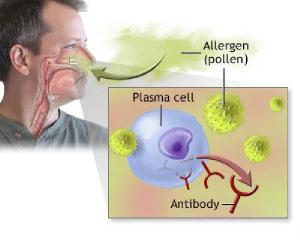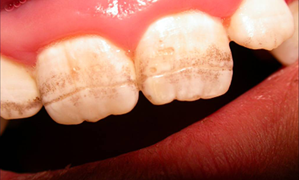This article is about “allergies not only in spring”. Springtime is the time of spring allergies: those affected develop a runny nose, itchy eyes and in more severe cases they may experience a flare-up of asthma. Allergies can be triggered by the increase of pollen counts in the air that occurs every spring. In those who are sensitive, this leads to antibody formation in the blood. But often people have not only sensitivities to the pollens of spring bloomers; they may also be allergic to spores from molds, to dust mites and may have underlying allergies to foods.
Memory cells of the immune system
The immune system has memory cells that memorize that a person has had an allergic encounter to one of these items in the past, and allergic reactions can become more significant with a future encounter. Allergies often get worse when a person has food sensitivities and there are cross reactions between pollens of trees or grasses that share surface protein regions with similar protein regions in foods.
Cross allergies
It is known that cross allergies are possible between birch pollen and apple, carrots or hazelnut. In its extreme form allergies due to antibodies, called IgE antibodies, can cause anaphylaxis. A person presensitized by inhaling birch pollen, after eating an apple, hazelnuts or a carrot can develop itching of the throat, swelling of the lips and very quickly deteriorate getting into an anaphylactic shock.
Other cross allergies exist between ragweed pollen, which is a powerful inhalant allergen and melons or bananas. Again there are specific IgE antibodies that are responsible for this immune reaction. In this case the ragweed allergy primes the immune system to produce IgE antibodies, which are experience potentiation by certain foods that share similar protein components as the ragweed pollen.
In the following I will deal with inhalant allergies separately from food allergies.
Inhalant allergies
Inhalant allergies are easier to diagnose and to treat than food allergies. Your doctor will likely refer you to an allergist when you have allergies that do not respond to treatment with intermittent over the counter antihistamines. Your symptoms may come on in the spring with itchy eyes and a runny nose. From year to year you find that you become more and more dependent on antihistamines and nose drops to unplug your nose. The allergist likely will do sensitivity tests, which consist of skin prick or scratch tests on the back or the forearms.
Allergy shots to stabilize allergies
In more serious allergies, where the patient has coughing and wheezing attacks following allergic reactions, the allergist may suggest to start intermittent allergy injections alongside the standard inhalation therapy for asthma. The allergist prescribes an allergy serum where the lab mixes ingredients based on all of the positive tests that led to a strongly positive skin reactions through allergy testing.
Allergy injections
Typically, the family doctor or his nurse will start the allergy injections initially in weekly intervals. After reaching the maintenance dose, there may be a modification to injections every 10 to 14 days.
The allergy injections stimulate the immune system to produce harmless competing antibodies, which counteract the disease producing allergic antibodies. In the process of desensitization shots the immune system will normalize, which means that the inflammatory response of the immune system settles down to normal.
This is not the end of the story with inhalant allergies. The allergist needs to retest the patient on a yearly basis. The immune system changes all the time as new allergies can develop and old ones may go away.
Retesting allergies and sublingual immunotherapy
Retesting is necessary to keep track of what is going on and to change the composition of the allergy serum. Those patients who are working together with the allergist can do very well, and often they gradually outgrow their allergies. Others may not be so lucky. They may have reactions to the allergy injections. In these cases avoidance of what causes the allergy may be the only solution to treat the allergies.
There is an alternative to allergy injections, which physicians in Europe use, namely a sublingual immunotherapy. Recently there has been a review of the literature for FDA approval that is needed for oral desensitization for ragweed, dust mites, grass pollen and cat dander. It will take some time before the FDA approval process will become a reality for sublingual desensitization in the US.
Allergies to pets
A special form of inhalant allergies are allergies to pets (mainly dogs and cats, but also allergies to petting zoo animals). The dander that the human comes in contact with is a protein from the animal hair. It causes hives when it touches the skin. This occurs as the dander penetrates through the skin and meets the local mast cells that release histamine. This in turn is responsible for the hive formation. Sneezing and even asthma can develop from inhaled protein particles that reach the lungs. Allergy injections for the treatment of animal dander allergies often do not help or make the allergies worse. The allergist usually recommends avoidance of animal contact as the solution, a recommendation, which the affected animal lover often does not appreciate.
Food allergies
Often we eat some foods more frequently, because they are our favorites. This means that our gut lymphocytes that get in contact with these foods can start to react to one or more of the foods we ingest. At this time we may experience abdominal cramps, diarrhea, vomiting and a host of other possible symptoms.
The physician will tell the patient that testing for food allergies is a problem. Most of the usual skin tests employed for inhalant allergies do not reliably work in determining food allergies. The doctor will ask the patient or the mother of the child with food allergies to keep a food diary and keep track of the allergic symptoms in the diary as well. An elimination diet will have to be devised based on the information gathered in the diary as it becomes clear from that record which foods cause which symptoms. The foods causing allergic symptoms are subsequently eliminated. This is a cumbersome process, but it is the most reliable method of testing and treating food allergies.
RAST test
In the past there was a blood tests, called RAST test, which tested for common food allergies that can cause severe allergic reactions like egg, milk, peanut, tree nuts, wheat, crustacean shellfish and soy. Since about 2010 this has been replaced by the more sensitive ImmunoCAP Specific IgE test.
Children often develop food allergies to egg, milk, wheat, nuts, peanuts and soy, which are food allergies with positive IgE tests. When they age, their immune system develops tolerance to many of these foods and they often outgrow these allergies.
Antibody tests for food allergies
Only a blood drop is necessary to test a panel of foods with IgG, IgM and IgE antibodies. A number of suppliers offer these tests. However, the specificity, sensitivity and reliability can pose problems with regard to the interpretation of the results. Allergists often point out that a test may be a false positive when a person likes certain foods. IgG antibodies against this food show up despite the patient having no symptoms. Another specialist may interpret this to indicate that the body shows early sensitization to a certain food. However, clinically it is not yet obvious. In other words, the sensitivity of the test is so high that it undermines the validity of the test. Recently a panel of international scientists reviewed the validity of these IgG based food intolerance tests and they found the tests not reliable.
Testing for food allergies
The immune responses to food allergies are complex as there are immediate type immune reactions and delayed type immune reactions. The physician investigates the immediate immune responses with the above mentioned ImmunoCAP Specific IgE test. The delayed immune responses can be measured using the ELISA test.
Other considerations about allergies
You see from this discussion that a patient with allergies needs a properly trained allergist who will do a comprehensive analysis involving a thorough history, examination, blood tests and immune tests. The specialist interprets the test results, which requires his/her experience and clinical judgment.
Clearfield wheat
Since the 1970’s when Clearfield wheat was introduced around the world on a large scale, which has a much higher gliadin (gluten) content than the old wheat varieties. As a result of exposure to this new type of wheat gluten intolerance and leaky gut syndrome have increased. Scientists registered a substantial increase in wheat gluten intolerance in the world population. Genetically modified foods like soy, corn, sugar beets, canola and more are a challenge for the immune system. This is particularly so in sensitive humans. Physicians do not fully understand why this is so. We do know that some people can develop autoimmune diseases. This may be the reason that a host of diseases are much more common now than in the past. Common autoimmune diseases are MS, rheumatoid arthritis, Hashimoto’s thyroiditis, ankylosing spondylitis and others.
Epi-Pen, chronic inflammatory diseases
After food elimination for 2 to 12 months depending on the severity of the food allergy, your body may have eliminated the allergy to the food you have avoided, in other words your body built up tolerance. Before you expose yourself to any food that you used to be allergic to and that you want to re-test, it is best to have an EpiPen ready in case your allergy has not resolved. Caution is necessary with regard to foods that cause more severe allergies, e.g. shellfish or peanuts. These type of allergies may last life long. It is safer to avoid these foods that cause more severe allergies altogether.
Chronic inflammatory diseases
Allergic reactions of the immune system belong into the category of chronic inflammatory diseases. These are known to be the root of chronic diseases like asthma, arthritis, heart disease, high blood pressure and cancer. Be vigilant about allergies and get proper assessment and treatment by an allergist. You will prevent serious health problems including the above mentioned chronic diseases.
More on asthma, which is a chronic inflammatory lung condition, often associated with multiple environmental allergies:















